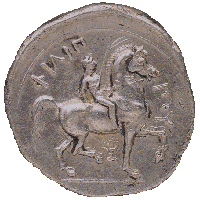Religious
Games
Horse Racing
 Only
the very rich could afford to train the horses and to hire the riders
and drivers for horse and chariot races. Such races were the
centerpiece events at the major Panhellenic festivals. Philip II of
Macedon's horse won the Olympic flat race in 356 BC, supposedly on
the day of his son Alexander's birth. Philip went on to win in the
four-horse chariot event at a number of Olympiads.
Only
the very rich could afford to train the horses and to hire the riders
and drivers for horse and chariot races. Such races were the
centerpiece events at the major Panhellenic festivals. Philip II of
Macedon's horse won the Olympic flat race in 356 BC, supposedly on
the day of his son Alexander's birth. Philip went on to win in the
four-horse chariot event at a number of Olympiads.
The four-horse chariot event carried the greatest
prestige in the world of Greek athletics. The running distance for
teams of full-grown stallions was extremely long by today's
standards: 12 laps or over 9 kilometers. Eight-lap events were staged
for teams of colts. The emphasis was on the animals' endurance and
their driver's skill at avoiding collisions.
The chariots were light two-wheeled carts with
flimsy rails across the front and down the sides. Since they had no
springs, they must have bounced around when driven at speed. The
drivers wore no protective headgear. While the starting fields were
large - in later times consisting of as many as 40 teams - the risks
were huge and many did not finish.
Attic Black Figure Amphora
Early 5th century BC
By the Diosphos Painter
On loan, Philadelphia Museum of Art
L-64-177
The goddess Athena driving a four-horse chariot or
quadriga.
H. 18.8; Dia. 12.0 cm. UM neg. S8-2828.
 Silver Tetradrachm
Silver Tetradrachm
ca. 342-336 BC
Philip II of Macedon
29-126-58
Young naked rider on a walking horse, carrying a long victory palm.
This commemorates Philip's victory in the horse race at Olympia in
356 BC Inscribed philippou or "coin of Philip."
Dia. 26.0 mm. Photo courtesy D. White.





The Ancient Greek World Index
 Only
the very rich could afford to train the horses and to hire the riders
and drivers for horse and chariot races. Such races were the
centerpiece events at the major Panhellenic festivals. Philip II of
Macedon's horse won the Olympic flat race in 356 BC, supposedly on
the day of his son Alexander's birth. Philip went on to win in the
four-horse chariot event at a number of Olympiads.
Only
the very rich could afford to train the horses and to hire the riders
and drivers for horse and chariot races. Such races were the
centerpiece events at the major Panhellenic festivals. Philip II of
Macedon's horse won the Olympic flat race in 356 BC, supposedly on
the day of his son Alexander's birth. Philip went on to win in the
four-horse chariot event at a number of Olympiads.
